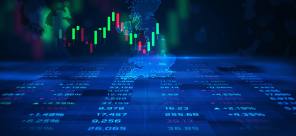PARTNER CONTENT by ARTEMIS
This content was paid for and produced by ARTEMIS
Nvidia recently unveiled the world’s most powerful artificial intelligence (AI) chip, the B200 Blackwell, which the company says is up to 30 times faster than its previous market-leading chip.
With interest in AI white hot, the announcement made headlines around the world. Nvidia says the new chip will be twice as powerful at training large language AI models and will dramatically increase the speed at which ChatGPT and other AI models can respond to queries.
The B200 Blackwell is at the forefront of a semiconductor industry that McKinsey forecasts will grow by 6% to 8% annually until 2030, by which time annual revenues are predicted to reach $1 trillion.
This rapidly growing global appetite for chips is not only being driven by the explosion in the use of AI. Today chips are used in everything from weapons systems to washing machines. A new car rolling off the production line is likely to use between 1,000 and 3,000 semiconductor chips – and 5G phone networks, the Internet of Things and Blockchain technology all need huge amounts of chips.
The majority of the chips we use are central processing units (CPUs), which are generally comprised of between four and eight cores that process and perform tasks. Although CPUs are very fast, the growing demands of AI mean we need more and more powerful processing power.
The B200 Blackwell is a graphics processing unit (GPU). These chips were initially developed for gaming and video editing, which demand very fast, heavy-duty processing, and they can have hundreds of cores that work in parallel to simultaneously execute a series of tasks. This processing power means they are far quicker than CPUs.
Geopolitics
While globally the appetite for chips is growing exponentially, the exact level of demand at any given time can be very difficult to predict. This leads to shortages and periods of oversupply, which can result in sharp moves in the share prices of chip-making companies, as experienced by Nvidia in 2022. The key point though is that over the long term demand for chips is growing at a powerful pace.
As chips play an increasingly vital role in our lives, they have become an important geopolitical issue. In 1990 the US produced 37% of the world’s chips1. Today the US government believes that figure has fallen to only 12%1, which is roughly on a par with Europe2.
The world is hungry for chips and Joe Biden is committed to significantly increasing production in the US, through the CHIPS Act. It is estimated that the construction of between $223bn and $260bn 3 worth of US semiconductor production facilities is proposed or under way, supported by $52.7bn worth of grants4. As these figures highlight, semiconductor fabrication plants – widely known as fabs – are costly to build. Construction is also time consuming, with even the most efficient projects taking in excess of three years to complete. In addition, there is the need to recruit the skilled staff vital for manufacturing.
Companies we’re backing
We believe chips are a strong secular growth theme, so the important question for asset allocators is how they should approach investing in this long-term growth story. In the past, we included chips within the ‘automation’ theme in our global portfolio. Now though, they have been elevated to a standalone theme.
Nvidia is currently a small holding in the Artemis Global Select Fund. Over a decade ago the company grasped the potential of parallel processing and invested accordingly – stealing a substantial march on its rivals.
The company first introduced GPUs back in the 1990s and has used this expertise to provide the technology for datacentres and to power AI models, which has driven the eye-watering surge in Nvidia’s share price.
However, we also hold Taiwan Semiconductor Manufacturing Company which dominates the production of the world’s cutting edge semiconductors. TSMC’s primary production facilities are in Taiwan, which poses clear risks due to tensions with China, so we welcome the fact the company is building facilities in the US and elsewhere. In addition, we own chip-makers Samsung Electronics and Micron and we are also invested in companies such as ASML and LAM Research, which make chip-manufacturing equipment.
We take an active approach to managing our long-term positions, using the volatility caused by the cyclical nature of the sector to identify attractive opportunities to buy and sell, while maintaining our focus on companies that have strong market positions, market-leading technology and excellent long-term growth prospects. This necessitates continual research and a close eye on markets. However, we believe it is an approach that can help the rapidly growing global demand for chips make a strong contribution in a balanced portfolio.
Alex Stanić is lead manager of the Artemis Global Select Fund.
1 https://www.cfr.org/blog/us-investment-semiconductor-manufacturing-building-talent-pipeline
2 Who ate all the ‘chips’? | Credit Suisse Asset Management (credit-suisse.com)
FOR PROFESSIONAL INVESTORS AND/OR QUALIFIED INVESTORS AND/OR FINANCIAL INTERMEDIARIES ONLY. NOT FOR USE WITH OR BY PRIVATE INVESTORS.
This is a marketing communication. Before making any final investment decisions, and to understand the investment risks involved, refer to the fund prospectus, available in English, and KIID/KID, available in English and in your local language depending on local country registration, from www.artemisfunds.com or www.fundinfo.com. CAPITAL AT RISK. All financial investments involve taking risk and the value of your investment may go down as well as up. This means your investment is not guaranteed and you may not get back as much as you put in. Any income from the investment is also likely to vary and cannot be guaranteed.
Market volatility risk: The value of the fund and any income from it can fall or rise because of movements in stockmarkets, currencies and interest rates, each of which can move irrationally and be affected unpredictably by diverse factors, including political and economic events.
Currency risk: The fund’s assets may be priced in currencies other than the fund base currency. Changes in currency exchange rates can therefore affect the fund's value.
Emerging markets risk: Compared to more established economies, investments in emerging markets may be subject to greater volatility due to differences in generally accepted accounting principles, less governed standards or from economic or political instability. Under certain market conditions assets may be difficult to sell.
Charges from capital risk: Where charges are taken wholly or partly out of a fund's capital, distributable income may be increased at the expense of capital, which may constrain or erode capital growth.
ESG risk: The fund may select, sell or exclude investments based on ESG criteria; this may lead to the fund underperforming the broader market or other funds that do not apply ESG criteria. If sold based on ESG criteria rather than solely on financial considerations, the price obtained might be lower than that which could have been obtained had the sale not been required.
Investment in a fund concerns the acquisition of units/shares in the fund and not in the underlying assets of the fund.
Reference to specific shares or companies should not be taken as advice or a recommendation to invest in them.
For information on sustainability-related aspects of a fund, visit www.artemisfunds.com.
The fund is an authorised unit trust scheme. For further information, visit www.artemisfunds.com/unittrusts.
Third parties (including FTSE and MSCI) whose data may be included in this document do not accept any liability for errors or omissions. For information, visit www.artemisfunds.com/third-party-data.
Any research and analysis in this communication has been obtained by Artemis for its own use. Although this communication is based on sources of information that Artemis believes to be reliable, no guarantee is given as to its accuracy or completeness.
Any forward-looking statements are based on Artemis’ current expectations and projections and are subject to change without notice.
Visit www.artemisfunds.com/glossary for an explanation of investment terms.
Issued by Artemis Fund Managers Ltd which is authorised and regulated by the Financial Conduct Authority.
Find out more

Related Content








